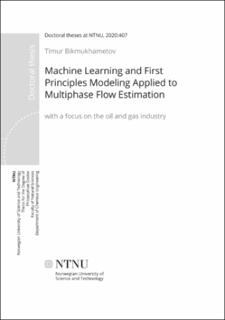| dc.contributor.advisor | Jäschke, Johannes | |
| dc.contributor.advisor | Skogestad, Sigurd | |
| dc.contributor.author | Bikmukhametov, Timur | |
| dc.date.accessioned | 2021-01-25T14:07:12Z | |
| dc.date.available | 2021-01-25T14:07:12Z | |
| dc.date.issued | 2020 | |
| dc.identifier.isbn | 978-82-471-9628-1 | |
| dc.identifier.issn | 2703-8084 | |
| dc.identifier.uri | https://hdl.handle.net/11250/2724598 | |
| dc.description.abstract | Accurate knowledge of multiphase flowrates produced by each well in an oil and gas production system is important for performing production optimization, flow assurance and reservoir management. Among the alternatives, estimation methods, often referred as Virtual Flow Metering, are promising in terms of high level of accuracy given the low cost of the solution. Virtual Flow Metering systems use readily available field measurements and estimate multiphase flowrates by means of mathematical modeling of a production system.
The main objective of this work is to review the current state-of-the-art multiphase flowrate estimation methods and further develop new estimation solutions based on combining physical knowledge about petroleum production systems and machine learning techniques.
The literature review shows that current approaches for creating Virtual Flow Metering systems mostly rely on first principles models of petroleum production system parts. However, despite the reasonable accuracy of these models, their estimation uncertainty and sensitivity to erroneous field measurements has not been studied in detail yet. We address this issue in Chapter 4, where, in the first part, we create a first principles Virtual Flow Metering system based on a commercial multiphase flow software and optimization engine and study the sensitivity of the resulting solution to erroneous field measurements. In the second part, we investigate how Bayesian Machine Learning can help in uncertainty estimation of first principles multiphase flow models based on the available field data. In addition, the literature review shows that applications of machine learning to multiphase flowrate estimation problems are promising and have been gaining momentum in the last several years. However, in the vast majority of cases, the created machine learning Virtual Flow Metering solutions are based on feed-forward neural networks which use raw field data without any multiphase flow physics consideration. This results in black-box solutions which are hardly used in industry because productions engineers do not trust the produced results. We address this problem in Chapter 3, where, in addition to feed-forward neural networks, we investigate capabilities of gradient boosting machine learning algorithm and recurrent neural networks, and combine them with multiphase flow physics to create accurate and explainable data-driven Virtual Flow Metering solutions. The results of this work show that first principles Virtual Flow Metering systems are very sensitive to measurement drift, and production engineers must carefully address this issue when tuning the software to the available field measurements. In addition, it was revealed that by combining Bayesian machine learning methods with first principles modeling, it is possible not only to tune first principles models to field conditions accurately, but also quantify the estimation uncertainty depending on the distribution of the historical data as well as process conditions. As a result, it becomes possible to understand when there is a need for model recalibration or performing condition maintenance.
This work also demonstrates that by combining machine learning with first principles models, it is possible to create robust hybrid multiphase flow estimation solutions with enhanced accuracy and explainability of the resulting data-driven models.
The results from this work can further be extended towards more advanced combinations of machine learning methods and first principles models, especially for dynamic process conditions. In addition, various combinations of Bayesian machine learning approaches with first principles modeling can further be developed in order to create a basis for robust, trustworthy and auto-tunable models applied to multiphase flowrate estimation tasks. | en_US |
| dc.language.iso | eng | en_US |
| dc.publisher | NTNU | en_US |
| dc.relation.ispartofseries | Doctoral theses at NTNU;2020:407 | |
| dc.relation.haspart | Paper 1: Bikmukhametov, T. and Jäschke, J. (2019). First principles and machine learning virtual flow metering: a literature review. Journal of Petroleum Science and Engineering, Volume 184, 106487, 3037–3043, doi.org/10.1016/j.petrol.2019.106487 | en_US |
| dc.relation.haspart | Paper 2: Bikmukhametov, T., and Jäschke, J. (2019). Oil Production Monitoring using Gradient Boosting Machine Learning Algorithm. IFAC-PapersOnLine, Volume 52(1), 514-519, doi.org/10.1016/j.ifacol.2019.06.114 | en_US |
| dc.relation.haspart | Paper 3: Bikmukhametov, T., and Jäschke, J. (2020). Combining Machine Learning and Process Engineering Physics Towards Enhanced Accuracy and Explainability of Data-Driven Models. Computers and Chemical Engineering, Volume 138, 10683, doi.org/10.1016/j.compchemeng.2020.106834 | en_US |
| dc.relation.haspart | Paper 4: Bikmukhametov, T., Stanko, M., and Jäschke, J. (2018). Statistical Analysis of Effect of Sensor Degradation and Heat Transfer Modeling on Multiphase Flowrate Estimates from a Virtual Flow Meter. In SPE Asia Pacific Oil and Gas Conference and Exhibition. Society of Petroleum Engineers, doi.org/10.2118/191962-MS Not included due to copyright restrictions. | en_US |
| dc.relation.haspart | Paper 5: Bikmukhametov, T., and Jäschke, J. Uncertainty Estimation of Mechanistic First Principles Models and Digital Twins Using Bayesian Machine Learning. Submitted to Engineering Applications of Artificial Intelligence, 2020.p This article is awaiting publication and is therefore not included. | en_US |
| dc.title | Machine Learning and First Principles Modeling Applied to Multiphase Flow Estimation | en_US |
| dc.type | Doctoral thesis | en_US |
| dc.subject.nsi | VDP::Matematikk og Naturvitenskap: 400::Kjemi: 440 | en_US |

